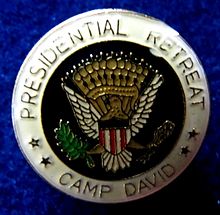Camp David
![]()
The title of this article is ambiguous. For other meanings, see Camp David (disambiguation).
Presidential Retreat "Camp David" is the unofficial but widely known name for Naval Support Facility Thurmont, officially known as Camp 3. Located in the Catoctin Mountain recreation area in Frederick County, Maryland, on the edge of the Blue Ridge Mountains, the facility serves as a recreation facility for the sitting President of the United States, away from the normal seat of government and day-to-day political business at the White House in Washington, D.C.
Camp David is located just a few miles from the Site R bunker complex, also known as Raven Rock. Camp David owes its current unofficial name to President Dwight D. Eisenhower, who named it after his grandson David. As the official designation indicates, the facility is administered by the United States Navy.
Camp David, in addition to its role as a holiday retreat for the American president and his family (First Family), has often been used in recent history as a venue for formal and informal talks between the US and heads of government of other states. Probably the best known was the Camp David peace agreement between Anwar as-Sadat and Menachem Begin, which led to the peace treaty between Egypt and Israel in 1979, mediated by Jimmy Carter.
In 2000, renewed talks to resolve the Israeli-Palestinian conflict failed at the summit between Bill Clinton, PLO leader Yasser Arafat, and Israeli Prime Minister Ehud Barak. This meeting is known as Camp David II.

Margaret Thatcher and Ronald Reagan at Camp David, 1986

Main house of Camp David (photograph: 1971)

Cuff links of Richard Nixon, Camp David edition in the private possession of a German collector
History
Catoctin Mountain Park was originally a very unprofitable tract of land that was converted into a recreational facility by the government in 1936. The purpose was to show how barren, rugged terrain and eroded soil could be converted into economically viable land. The first camp, Misty Mount, was used for a year by the Maryland League for Handicapped Children, but they subsequently moved to Camp Greentop because the terrain was more suitable for wheelchair users. A third camp, Hi-Catoctin, then completed in the winter of 1938-39, served as a summer camp for civil service families for three years.
The then President Franklin D. Roosevelt used to spend weekends and summers relaxing aboard his yacht Potomac or in Hyde Park in New York State. When in 1942 - after Japan's attack on Pearl Harbor and the maneuvering of German U-boats in the Atlantic - the overall situation became increasingly dangerous, a new resort was sought within 100 miles outside Washington, D.C. in a safe, cool mountain location for the president's safety and also health.
Several locations were considered; after Roosevelt's first visit to Camp Hi-Catoctin on April 22, 1942, this was chosen. There was already a facility, the remodeling cost was $18,650, and last but not least, the area was about ten degrees cooler than Washington, which benefited the president's challenged respiratory system. Thus the holiday camp for civil servants' families became a holiday camp for a "civil servant," the president. Roosevelt renamed the place Shangri-La, inspired by the novel Lost Horizon by James Hilton.
Toward the end of World War II, there was debate over what should become of Shangri-La, the former presidential country estate: should it be returned to the National Park Service or preserved as a national monument? Or should it be returned to its original purpose and given back to the Maryland State Forest as a model site?
In 1952, President Harry S. Truman agreed to a compromise that the land north of Route 77 would continue to be managed by the National Park Service and the land south of it would be transferred to Cunningham Falls State Park. The official transfer took place in 1954. President Dwight D. Eisenhower then named the site Camp David after his grandson.
At the invitation of US President Jimmy Carter, peace negotiations between Israel's Prime Minister Menachem Begin and Egypt's President Anwar as-Sadat began at Camp David on September 5, 1978. In addition to these historic Israeli-Palestinian talks, numerous meetings and conversations of significance have taken place in the private, secluded atmosphere of the camp: the planning of the Normandy landings in World War II, the meetings between Eisenhower and Nikita Sergeyevich Khrushchev, negotiations over the Bay of Pigs crisis, the Vietnam War, and other discussions with rulers, foreign dignitaries, and guests.
A G8 summit was held here on May 18-19, 2012.
The Presidential Camp is located within the boundaries of the National Park; it is not open to the public. This is for security reasons and to ensure the privacy of those there.
Questions and Answers
Q: What is Camp David?
A: Camp David is an official residence of the President of the United States.
Q: Where is Camp David located?
A: Camp David is northwest of Washington D.C., in Catoctin Mountain park.
Q: Who provides staffing for Camp David?
A: The U.S. Navy and the U.S. Marine Corps provide staffing for Camp David.
Q: What is the official name of Camp David?
A: The official name of Camp David is Naval Support Facility Thurmont.
Q: How is Camp David different from other official residences of the US President?
A: Camp David is located outside of Washington D.C. and is situated in a mountain park, whereas the other official residences are located in the heart of the city.
Q: What is the role of the U.S. Navy and U.S. Marine Corps at Camp David?
A: The U.S. Navy and U.S. Marine Corps provide staffing for Camp David, including security and hospitality services.
Q: Can the public visit Camp David?
A: No, Camp David is not open to the public and is only accessible to authorized personnel.
Search within the encyclopedia